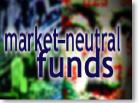|
A hedge against the market
|
 |
April 21, 1998: 5:04 p.m. ET
Market-neutral mutual funds short-sell stocks, and try to eliminate risk
|
NEW YORK (CNNfn) - Imagine a mutual fund that eliminates risk -- where your money can grow without any threat from bearish market swings.
A 1997 change in the U.S. tax code allows mutual funds to try the same "market-neutral" strategy of short-selling stocks that millionaires have used for years in hedge funds.
"It's the purest form of money management," said Dick Saalfeld, president of Barr Rosenberg Mutual Funds, a San Francisco-based company that introduced the Barr Rosenberg Market Neutral Fund in December.
About a dozen other market-neutral funds, including the Montgomery U.S. Market Neutral Fund and the Euclid Market Neutral Fund, are waiting for approval from the Securities and Exchange Commission.
Market-neutral funds operate on a theory of "neutralizing" market risk by investing half the portfolio in long positions -- in stocks they believe are undervalued and will rise. The funds "short" the other half of the portfolio in stocks they believed are overvalued and will fall.
"Shorting" involves borrowing stock at a certain price from a brokerage and then selling it on the market. You agree to repurchase the shares later and return the borrowed shares. The profit comes if the stock price falls.
Market-neutral funds also invest in U.S. Treasuries -- and attempt to beat their returns.
Federal law prevented mutual funds from earning more than 30 percent from short-term gains until the repeal last year of the so-called "short-short" rule as part of the Taxpayer Relief Act.
The Barr Rosenberg Market-Neutral Fund earned .4 percent between inception and April 16, according to Lipper Analytical Services. Saalfeld said the fund is less concerned with quarterly results but hopes to net 10 to 12 percent a year.
Barr Rosenberg Mutual Funds have used a similar strategy for institutional investors and earned annual returns of 13.85 percent since 1989, Saalfeld said.
Saalfeld said the market-neutral fund, without advertising, grew from $3 million in assets in December to more than $200 million.
The Barr Rosenberg fund is different from a traditional hedge fund because it doesn't rely on market timing, Saalfeld said. Barr Rosenberg, managing general partner for Rosenberg Institutional Equity Management, developed formulas to limit every conceivable risk, Saalfeld said.
Rosenberg earned his doctorate from Harvard University and was an economics professor at Berkeley.
"We shun the word 'hedge,' " Saalfeld said. "That's people who short stocks and are market-timers. Hedge funds connote risk."
But there are risks with market-neutral funds. One potential problem is the tax liability. The short positions are all considered short-term capital gains, taxed at regular income rates of up to 39.6 percent.
Another risk in a bull market is finding enough stocks to short.
Saalfeld argues the Barr Rosenberg fund holds about 400 stocks short and the same number long -- which limits its vulnerability.
"We buy a little of many companies," Saalfeld said. The company hasn't had any trouble finding good short positions -- but he declined to give any examples.
A market-neutral fund's success also depends on the fund manager's ability to balance longs and shorts, market watchers said.
"Not all people can execute this strategy with equal ability," said Susan Belden, editor of the No Load Fund Analyst, a newsletter that reviews no-load funds. "We think Rosenberg can do this because (the staff) has carefully developed quantitative models."
Of course, the obvious disadvantage is that an investor misses out on the stellar gains of the bull market.
"In the last three years, bonds have done OK, with yields around 6 percent," said Peter Canelo, U.S. investment strategist with Morgan Stanley Dean Witter in New York. "But the stock market has more than doubled."
Canelo thinks index funds are a better bet for investors. He's also not convinced a market-neutral fund can beat U.S. Treasury bills.
"You miss out in a bull market and you basically break even in a bear market," Canelo said.
But in the meantime, more market-neutral funds will be hitting Wall Street in 1998.
"When markets are richly valued, people look for investments that aren't related to the markets," Belden said. "I think the prognosis for this kind of fund is good."
Officials from the Montgomery and Euclid funds declined comment. The Euclid fund is in the "quiet period" of the SEC approval process and the Montgomery fund said plans are still in the works.
Barr Rosenberg plans to introduce its Double Alpha Market Fund sometime in the third quarter. The fund, waiting SEC approval, will invest in the market-neutral fund as well as in S&P 500 futures, Saalfeld said.
"That's what we're known for: it's all on formulas and identifying the risks of investing," Saalfeld said. "We're trying to reduce all the risks we can." 
-- by staff writer Martine Costello
|
|
|
|
|
 |

|

